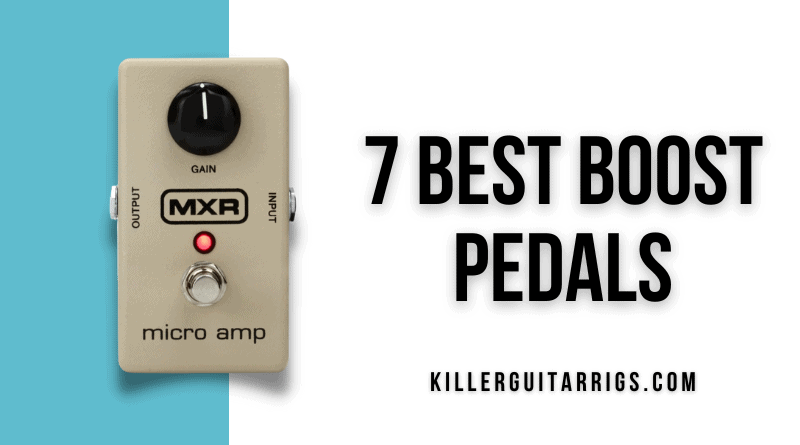One thing that all of the best boost pedals have in common is the ability to enhance tone without fundamentally altering the character of your guitar and amp, something that the MXR M133 Micro Amp Gain/Boost pedal does brilliantly. We really think this is one of the best choices on the market if you’re looking for great build quality, an easy to use interface, and tons of high gain boost on demand. It’s an especially great pairing with more powerful tube amps, as it allows for a pretty significant drop in headroom, netting you dirty, gritty tones and more saturation without needing to crank the amp itself. This pedal offers anywhere from 0.25 to 26dB of additional boost, making it extremely powerful for a compact model. You can power it with either a 9v battery, or with an adapter, which is the kind of flexibility we’d expect from our best boost pedals Top Pick award winner.
In the event you’re working with a bigger budget, we’d highly recommend looking towards the J. Rockett Audio Designs “The Jeff” Archer Boost/Overdrive pedal. This is an authentic reproduction of the late Jeff Beck’s own modified unit, and delivers an extremely similar vintage boost thanks to its real vintage “new old stock” diodes. This pedal really excels when it comes to clean boost, but it can also be used to push a tube amp into a beautiful saturated overdrive, too. It runs from standard 9v power, but uses trick circuitry and an internal charge pump that doubles the voltage to 18v. The organic tones from The Jeff are really quite spectacular, and can liven up even the dullest sounding amps. Again, it was a simple looking pedal, but the quality of the tones it delivered ensured that it took our Editor’s Choice award for the best boost pedals.
Players looking for a great boost pedal that doesn’t break the bank should look no further than the Electro Harmonix LPB-1 Nano Linear Power Booster. Despite being the most affordable in the whole roundup, this pedal offers some fantastic vintage boost that you’d swear was coming from a pedal twice its price. It comes in an all galvanized metal housing, making it pretty much indestructible. It’s one of the simplest boost pedals to use thanks to its single gain knob control, and because it’s a linear booster, the result of turning the gain up or down is incredibly smooth. Ultimately, the Electro Harmonix LPB-1 Nano Linear Power Booster offers some of the best value you’ll get from any boost pedal, which is why we named it our best boost pedals Best Budget pick.
Read more about our review process.
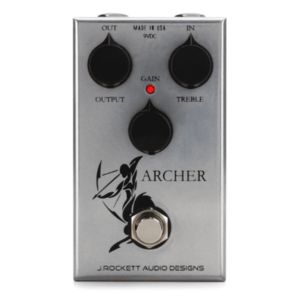
J. Rockett Audio Designs The Jeff Archer Boost/Overdrive Pedal
Features: Vintage NOS diodes, Internal charge pump, Direct treble control
Benefits: Harmonically rich tone, Huge clean headroom, Excellent responsiveness
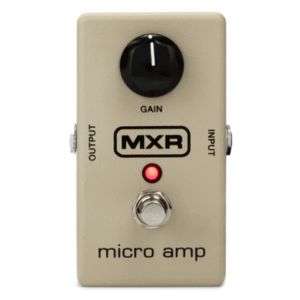
MXR M133 Micro Amp Gain / Boost Pedal
Features: 1 Knob control interface, LED on/off indicator, All metal construction
Benefits: Increased volume and presence, Compact footprint, Retains inherent character of guitars/amps
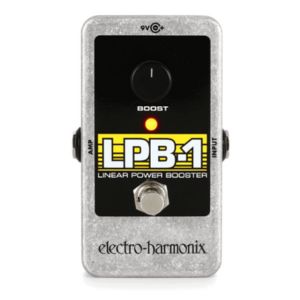
Electro-Harmonix LPB-1 Nano Linear Power Booster
Features: True bypass switching, Linear boost, All metal construction
Benefits: Amazing clarity increase, Enhanced tonal versatility, Superb build quality
Contents
Individual Reviews

MXR M133 Micro Amp Gain / Boost Pedal
MXR is a well-known brand among pedal enthusiasts. They offer a vast variety of great-sounding pedals that are also durable and well-designed. This is certainly the case with the M133, a pure boost that is as straightforward as they come.
The MXR M133 Micro Amp Gain / Boost Pedal features a single rotating control knob and a red LED on top in a very streamlined design. With true bypass and simple I/O, this pedal is assembled at Dunlop in California for quality control.
The pedal’s Gain control goes from 0.5 dB to 26 dB when turned fully clockwise. This is plenty of gain to help your tone come up and cut through just about anything.
In our tests, the M133 proved to be a booster pedal in its purest form. In other words, we got no coloration on our sound even with the gain knob turned past its midpoint. We actually liked this, as it can be quite useful when you just want to keep your tone but at a higher volume for a solo, or similar.
This pedal is powered by a nine-volt battery or you can opt to get an adaptor separately. This unit is well-built and small enough to fit in tight pedalboards and gives you a battery life of about 50 hours of use.
In short, a useful booster that preserves your tone even at high levels. Folks looking for a bit of personality or more features should consider other options.
Verdict: The MXR M133 Micro Amp Gain / Boost Pedal is a simple and basic booster that features a single rotating control knob and a red LED indicator. It comes with true bypass and allows you to boost your tone without coloring your sound, even at high-gain settings.
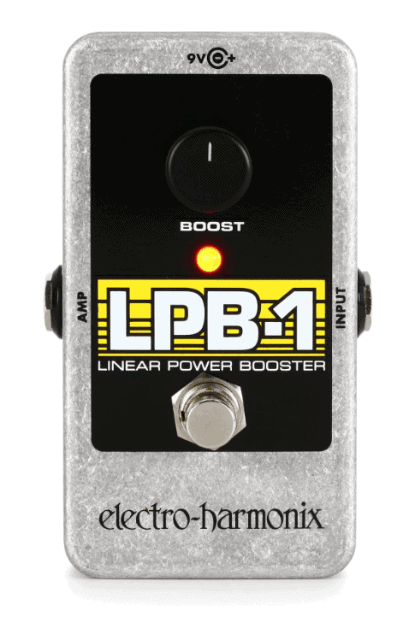
Electro-Harmonix LPB-1 Nano Linear Power Booster
A vintage booster that delivers for today's player.
Electro-Harmonix is among the best companies in the pedal industry. They are a brand that has stood the test of time as numerous legendary guitar players past and present rely on their pedals. The LPB-1 brings all the quality and durability we've to expect from EHX and is a fantastic booster pedal.
The Electro-Harmonix LPB-1 Nano Linear Power Booster is a re-creation of the original LPB-1 circuit, which was fundamental for the popularity of overdrive back in 1968.
It is basically a vintage booster, featuring a single Gain knob and the pedal switch, and is built in the nearly indestructible Electro Harmonix aluminum chassis.
We tried this pedal with our Fender Strat plugged into our Twin Reverb amp. It gave us a tone and performance that was the difference maker in our tone. When we slowly pushed the Gain knob up clockwise we got not only added gain but a nice increase in the definition of our tone.
This pedal is a linear booster, which makes it that much more musical. In layman’s terms, the change in volume and tone we experienced while moving the gain know was quite smooth.
In regard to tonal transparency, the vintage circuit on the LPB-1 does not disappoint. The true tone of our Strat came through at all times during our tests. In true EHX fashion, this pedal is built to the highest standards and can certainly be an asset on your pedalboard.
Despite the evident simplicity of this unit, there is a lot you can do with it. With some time and patience, you can figure out how to implement this pedal into your signal chain for the best results that suit your particular needs.
In short, a fantastic booster by EHX, with great sound, and built like a tank.
Verdict: The Electro-Harmonix LPB-1 Nano Linear Power Booster is a re-creation of the original LPB-1 circuit, which played a fundamental role on the popularity of overdrive in the late sixties. This vintage booster features a single Gain knob and is quite durable.
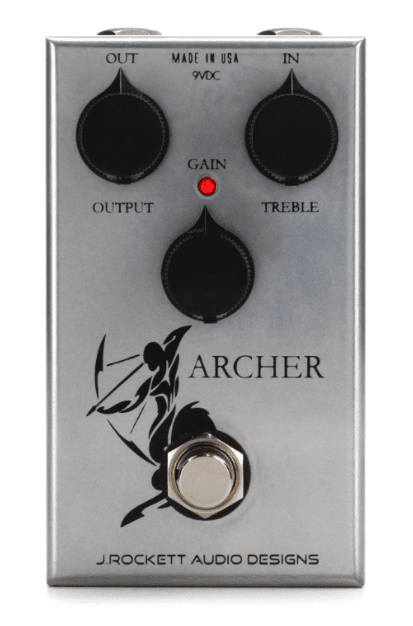
J. Rockett Audio Designs Jeff Archer Boost/Overdrive Pedal
A superior boost pedal for dedicated professionals.
This pedal offers more than a boost, by giving you as much personality or transparency, according to your needs. It is simple to use and very durable, great for a variety of uses and contexts.
The J. Rockett Audio Designs Jeff Archer Boost/Overdrive Pedal is a limited-edition version of J. Rockett Audio’s popular high-headroom transparent overdrive pedal. This unit features the veneered K-style harmonic saturation of J. Rockett’s original unit.
Its design replaces some critical components like the germanium diodes, for vintage NOS variants. This pedal was designed to offer a vast amount of clean headroom as well as a fantastic ability to drive a tube amp.
The internal circuitry increases the operating voltage up to 18 volts which produces expanded output and clarity.
We tried this pedal with our Gibson Les Paul and Twin Reverb amp. We started by playing with the Gain control. As we turned it clockwise, we got a sweet, harmonically rich saturation, particularly around the mid-frequencies.
We then moved on to the Treble knob, which gave us different flavors, from a darker character to a midrange bite, all the way to a gorgeous top-end chime. We particularly liked the tone we got with the Gain control at 11 o’clock and the treble at 12 o’clock. Here we got a nice boost with overdrive characteristics that sat quite nicely for bluesy lines.
This pedal gave us an overall organic response, with a smooth top-end that paired very well with our wah pedal. It also gave us plenty of options for rhythm and lead parts, as a flexible and versatile tool.
This pedal can be powered by a 9-volt power supply or battery. In short, a superior boost pedal that gives you personality and pairs up with a variety of other pedals.
Verdict: The J. Rockett Audio Designs Jeff Archer Boost/Overdrive Pedal is a limited-edition version of the J. Rockett Audio transparent overdrive pedal. Well-built and versatile, this pedal gives you a unique boost that adds personality to your tone for both lead and rhythmic parts.
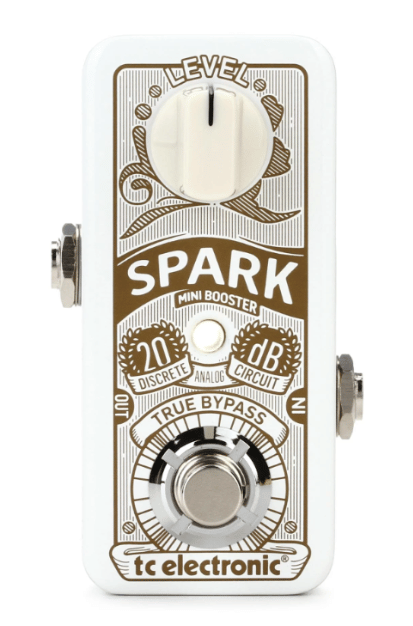
TC Electronic Spark Mini Booster
A straightforward booster that excels in convenience.
TC Electronic has a strong reputation for creating useful tools for guitarists. The Spark Mini Booster is no exception and gives you a transparent boost that can add a bit of grit when combined with pedals and tube amps.
The TC Electronic Spark Mini Booster features the company’s PrimeTime switching, which gives you two options: have the switch permanently on (latching) or just for as long as you hold it down (momentary).
With a design that incorporates a single knob that controls 20 dB of boost, this pedal is quite compact and will fit in nearly any cramped pedalboard. It also features a true bypass and a very durable enclosure.
We tried this pedal with our PRS Silversky plugged into our Roland JC-120 amp. We got a very transparent tone at various levels. In other words, the Spark Mini simply raises the level of your guitar signal.
We then tried it with our Twin Reverb and here we got a bit of bottom-end fattening as well as some treble sweetening past the 12 o’clock position. When we cranked it all the way clockwise, our tone had a nice grit which is great for single lines to stand out and to add that extra factor to rhythmic parts as well.
We then added the Spark Mini to our pedal chain, trying it in combination with our Tube Screamer and EHX Fuzz. We loved the extra bit of drive that it gave us, particularly for heavier riffs. The PrimeTime function also worked very well.
In short, a nice and compact pedal that can boost and add grit when combined with a tube amp or saturation pedals. As good as it sounds, some folks may want to go beyond this one knob design and consider other options.
Verdict: The TC Electronic Spark Mini Booster is a very compact pedal with a single knob that gives you up to 20 dB of boost. It features TC Electronic’s PrimeTime switching, which allows you to use the pedal in latching mode or momentary. Well-built and nicely designed, this pedal also offers true bypass switching.
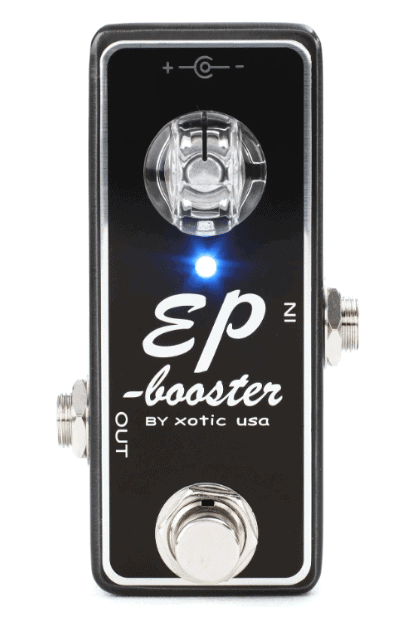
Xotic EP Booster Mini
A convenient pedal based on a classic.
This pedal gives you a straightforward boost with just a touch of personality. Well-built and very convenient, the EP Booster Mini can be that pedal that you have on all the time so push your tone and make it stand out.
The Xotic EP Booster Mini Pedal is based on the preamp stage of the vintage Maestro EP-3 echo effects processor, commonly referred to as the Echoplex. Legendary guitarists like Jimmy Page, Eddie Van Halen, and Eric Johnson relied on that particular preamp to craft many of their best-known studio tones.
The compact mini booster delivers up to 20 dB of boost and a rich character to your tone. It features internal dip switches for adjusting EQ and boost frequencies. Besides boosting, you can also hit your amp harder with this pedal, for an added tonal character.
For our tests, we plugged our Gibson Les Paul into our Fender Twin Reverb amp. The Xotic EP Booster gave us a nice boost that added just a bit of personality without changing our tone very much.
We liked it placed in the middle of our chain, although it also worked very well at the end of it to add a bit more color and body to our tone. This is the type of pedal that you can always have on and use in nearly all situations and contexts. This is mainly because you get a boost that does not alter your tone much but lets your signal stand out.
The EP Booster Mini also features true bypass switching and is powered via a 9-volt battery or an AC adapter that must be purchased separately. In short, a fantastic mini pedal that can help your tone stand out without coloring it. Naturally, for some folks, it may be a bit overpriced given its limited features.
Verdict: The Xotic EP Booster Mini is a miniature pedal that can boost your tone and add some character to it as well. It is based on the preamp stage of the Maestro EP-3 echo effects processor and comes with a single boost knob for streamlined operation.
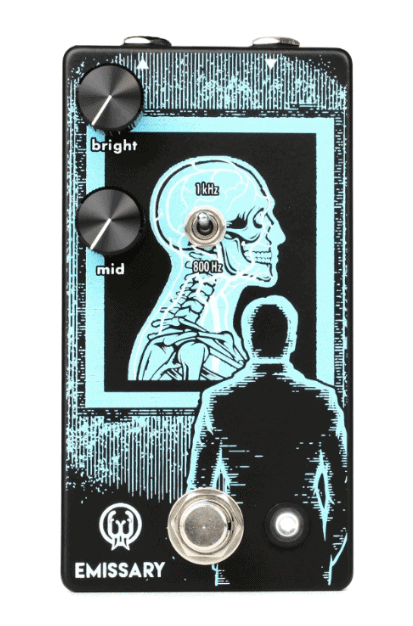
Walrus Audio Emissary Parallel Boost Pedal
A unique pedal with a double circuit for added flexibility.
This pedal is a cleverly designed unit that goes beyond offering a nice boost. It allows you to choose exactly how you boost it via its two circuits, which gives you a lot more flexibility than a regular boost pedal.
The Walrus Audio Emissary Parallel Boost Pedal is a 2-in-1 parallel boost pedal with a bright circuit featuring an ultra-clean JFET boost that brings out the higher frequencies and a Mid circuit for punch and presence.
This unit features two independent circuits, which basically makes this unit have two boost pedals in one. Each circuit is controlled by one of the two knobs this pedal has: Bright and Mid.
This pedal also features a 1 kHz to 800 Hz switch that allows you to specify a target frequency for the Mid circuit. Despite all these features, we really liked the fact that you can choose to use the main circuit by itself, or blend them by dialing each knob to your preferred level.
We started our tests with both dials at zero and brought up the bright boost to about 11 o’clock, for a very transparent signal with an extra touch of top end. Pushing it past 12 o clock, the personality of this pedal started to really show.
When testing the Mid control we got a nice low mids bump with the switch set at 1 kHz. On the other hand, with the switch at 800 Hz, we got the sound of a wah pedal placed halfway, which can work nicely in a variety of contexts and situations.
In short, a very well-built pedal by Walrus. It is also quite versatile and gives you more than just a total boost, as it can treat different frequency ranges separately.
Verdict: The Walrus Audio Emissary Parallel Boost Pedal is a 2-in-1 parallel boost pedal with a bright circuit and a mid-circuit for great versatility. This pedal is well-built and comes with an added frequency switch so you can target your preferred mid range frequency for added flexibility.
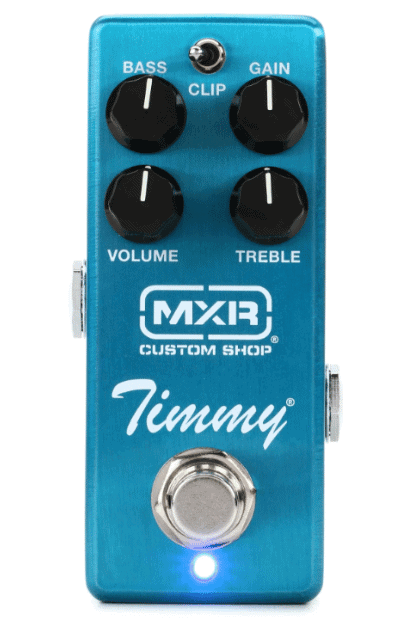
MXR Timmy
A convenient and powerful pedal with tons of personality.
This MXR pedal can go beyond giving just a boost, and adds several control possibilities for enhancing your tone. With your typical MXR quality and sturdy chassis, this pedal comes with four knobs and a 3 position switch to dial your desired amount of grit.
The MXR Timmy Overdrive Pedal is created by renowned pedal designer Paul Cochrane. He also produced the original Timmy Overdrive to great success. However, Mr. Cochrane needed the muscle of a larger company to satisfy the strong demand for this popular pedal.
We tried this pedal with our Strat into our Twin Reverb. It became clear from the beginning that this pedal works by cutting frequencies rather than adding. This clever design stops you from overhyping your signal and being more mindful about how you dial up your tone.
In our tests, we got a nice variety of natural tones for boosting and overdrive. Despite having many more features when compared to other boosters, this pedal (which is technically an overdrive) gave us intuitive operation that resulted in a natural-sounding tone.
The Bass control on this pedal is another great feature of the Timmy. It is designed to impact your signal before it gets to the overdrive stage. This produces a cleaner and more focused low end that gave us focused and balanced tones, particularly when playing rhythm parts in the mid-low frequencies.
To counter the Bass control, the Treble control impacts your signal after it hits overdrive. This smoothes out your sound and highlights harmonics. We also liked how the 3-way switch operates. It allows us to choose from three distinct clipping types, so we could go from a subtle overdrive to pronounced distortion.
In short, a fantastic pedal that goes beyond boosting. That said, it may be a bit too much for those interested in a traditional boost unit.
Verdict: The MXR Timmy Pedal is a good-sounding boost unit that offers boosting and overdrive. This pedal will be great for folks looking to go beyond just boosting with a unit that also excels at overdrive and distortion.
How to Choose The Right Pedal For You
Some of the best boost pedals can be versatile and an asset for your pedalboard. Boost pedals sometimes get a bad rep as a one-dimensional tool, but in reality, they can be the X factor that makes your guitar sing.
There are different models of boost pedals out there, and some go beyond the one-knob design to offer even more flexibility for your tone. In this guide, we’ll walk you through the main differences between these models.
Clean Boosts
The simplest boost pedal kind is the clean boost. These feature the most straightforward designs, featuring a single knob that gives you up to 20 decibels of clean signal for you to boost your signal.
Clean boosts raise your signal’s level while remaining colorless and transparent, with no distortion. When paired with other pedals in your rig, clean boosts will usually alter the attributes of your distortion, fuzz, or overdrive pedals, giving you something new on a tool that you are familiar with.
Treble Boosters
A treble booster pedal is usually a pedal with a single transistor and a design that is a bit more involved than what you’d find in clean boosters. One of its main attributes is rolling off a good chunk of low-end to create a sort of hi-pass filter.
The result is that your signal will have some additional top-end, and will enhance your amps clarity and prevent it from sounding too muddy. However, treble boosters can also present some challenges. For instance, it may be susceptible to shifts in temperature and will add a bit of extra noise if the circuit employs germanium transistors.
EQ Boost
EQ boost pedals give you more intricate layers of tonal complexity and give you more control over your overall tone. In essence, they allow you to emphasize specific frequencies or other tonal elements.
EQ pedals are particularly good for stacking up and combining with other pedals on your board, even more so than clean and treble boosters. By pairing an EQ boost with a fuzz or colorful overdrive, you open up another level of tonal potential when accentuating certain frequencies.
Preamp Boost
Preamp boosts are often based on the circuits of vintage pieces of audio gear. These emulation pedal models have become very popular in recent years, as folks want to replicate the tone of iconic and beloved gear.
That said, some preamp boost pedals don’t emulate classic gear and go for their own identity instead. Preamp boost pedals generally add more color than other types of boosts, and can also pair up nicely with saturation pedals.
Final Thoughts
Boost pedals can elevate, extend, and improve the tone of your guitar rig. They can also open a new palette of colors when stacked with other pedals, particularly if it is an EQ boost. Some popular boost pedals are often used constantly by a guitarist, as they add a nice touch to the tone without ever being intrusive.
Simply stated, the goal of a boost pedal is to increase the level of your guitar signal while avoiding the overt color or personality that you’d get from overdrive, distortion, or fuzz. Although some boost pedals can do what an overdrive does and vice-versa, this type of pedal is designed with a different end in mind which usually leads to different results.
To recap our choices for this article, our top pick, the MXR M133 Micro Amp Gain / Boost Pedal was a great performer with rock solid build quality. On top of that, it was incredibly simple to operate, meaning we didn’t need to work too hard for great tone.
The Electro-Harmonix LPB-1 Nano Linear Power Booster is our budget pick. This is a re-creation of the original LPB-1, and comes in a smaller enclosure that is built for the rigors of the road. This pedal features a vintage boost with personality and is quite affordable and durable.
Finally, our Editor’s Choice, the J. Rockett Audio Designs Jeff Archer Boost/Overdrive is a fantastic transparent boost and overdrive for discerning musicians that are willing to pay for quality. It features the iconic K-style harmonic saturation of J. Rockett’s original unit and offers a vast amount of clean headroom as well as a remarkable ability to drive a tube amp for added grit and punch.

